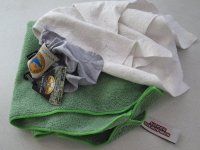BruceH
Avatar: Harris Hawk
A common denominator in many threads on lens cleaning is to use a microfiber cloth. However there are multiple types of these cloths.
Here are some examples I have seen:
- Most common have been cloths with a fuzzy nap.
- A thin silk like cloth supplied with some binoculars.
- A compressed cloth thicker than a thin cloth without nap.
There are probably more.
It also seems that not all microfiber cloths of the same type are of the same quality. Costco sells a large packet of a gold/yellow napped cloths that I use on windshields and they absorb quite well. However I got a free pack of napped cloths from Harbor Freight and the nap is shorter and they do not seem to absorb liquid near as well.
Are there any members who can inform the rest of us on everything we need to know about microfiber cloths?
- Are there some characteristics to look for in a microfiber cloth for lens clenaing?
- Are there some characteristics to avoid?
- Why is a microfiber cloth better than a cotton cloth?
- Is there any manufacturing residue that should be washed off before first using?
- Does microfiber absorb oily smudges without using a lens cleaner?
- Exactly what is microfiber compared to regular cotton?
The intent of this thread is to discuss microfiber cloths and how to use them cleaning lenses rather than to go into the details of cleaning optics. If you are knowledgeable on microfiber, here is your chance to share with the world what you know. If, like me, you want to know more about the subject, here is an opportunity to ask all of your questions.
What is the best birding microfiber cloth in the world and does it have to been green?
Here is a photo of the three examples mentioned above. The green cloth with the nap is the most common I have seen and came from the Walmart automotive section several years ago. The cloth attached to the pouch is the thin silk like cloth and was purchased at a birding festival. The white cloth is the thicker type without nap and was purchased at a swap meet like event.
Here are some examples I have seen:
- Most common have been cloths with a fuzzy nap.
- A thin silk like cloth supplied with some binoculars.
- A compressed cloth thicker than a thin cloth without nap.
There are probably more.
It also seems that not all microfiber cloths of the same type are of the same quality. Costco sells a large packet of a gold/yellow napped cloths that I use on windshields and they absorb quite well. However I got a free pack of napped cloths from Harbor Freight and the nap is shorter and they do not seem to absorb liquid near as well.
Are there any members who can inform the rest of us on everything we need to know about microfiber cloths?
- Are there some characteristics to look for in a microfiber cloth for lens clenaing?
- Are there some characteristics to avoid?
- Why is a microfiber cloth better than a cotton cloth?
- Is there any manufacturing residue that should be washed off before first using?
- Does microfiber absorb oily smudges without using a lens cleaner?
- Exactly what is microfiber compared to regular cotton?
The intent of this thread is to discuss microfiber cloths and how to use them cleaning lenses rather than to go into the details of cleaning optics. If you are knowledgeable on microfiber, here is your chance to share with the world what you know. If, like me, you want to know more about the subject, here is an opportunity to ask all of your questions.
What is the best birding microfiber cloth in the world and does it have to been green?
Here is a photo of the three examples mentioned above. The green cloth with the nap is the most common I have seen and came from the Walmart automotive section several years ago. The cloth attached to the pouch is the thin silk like cloth and was purchased at a birding festival. The white cloth is the thicker type without nap and was purchased at a swap meet like event.
Attachments
Last edited:





